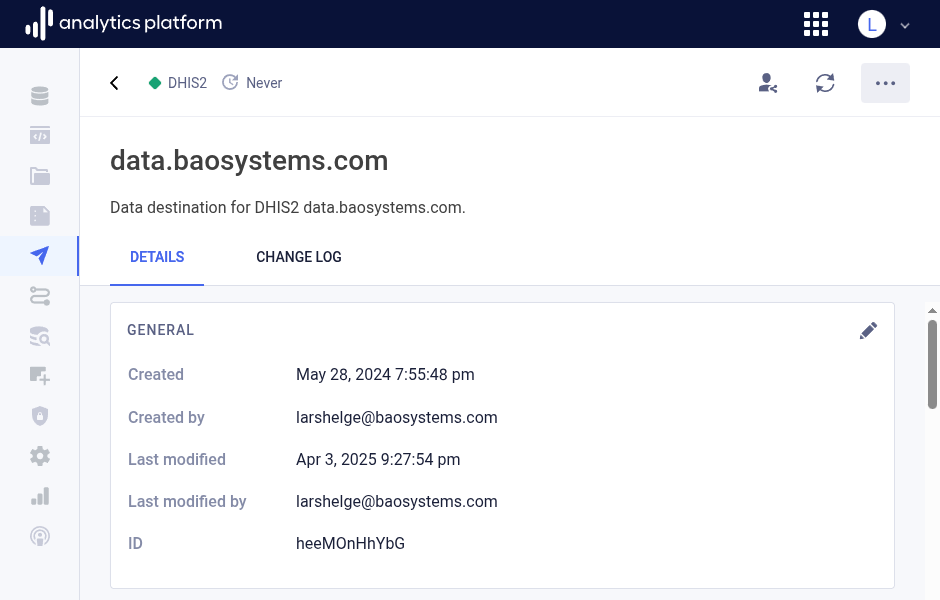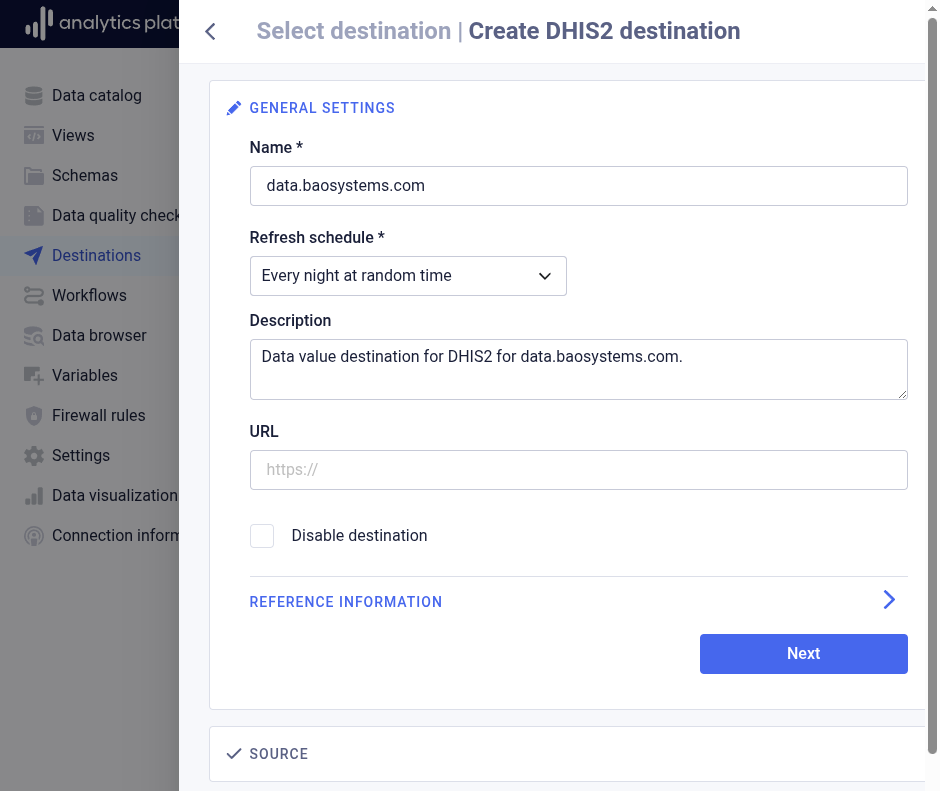Destinations¶
Overview¶
AP offers destinations for loading data from the platform back into operational systems. This is valuable in order to enrich the destination system with integrated and harmonized data from a variety of sources.
The following destinations are supported.
Applications¶
- DHIS2: A flexible, an open-source, web-based platform for collecting, analyzing and visualizing health data, widely used for managing and monitoring health programs, particularly in low-resource settings.
Manage destinations¶
The following section covers how to view, create, update and remove destinations.

View destination¶
- Click Views in the left side menu to view all destinations.
- Click the name of a view to see more information.
Create destination¶
- Click Create new from the top right corner.
- Chose the type of destination.

General settings
In the General settings section, enter the following information. This section is present for all data pipeline types.
| Field | Description |
|---|---|
| Name | The name of the destination (required) |
| Refresh schedule | The interval for when to refresh data from the data source (required) |
| Description | A description of the data pipeline |
| URL | A URL to the source data or system |
| Disable destination | Whether to disable loading of destination data |
| Reference | A reference text for the data source |
| Link to source | A URL refering to information about the data source |
| Link to terms of use | A URL refering to terms of use for the data source |
Source
In the Source section, select the view to use to retrieve destination data.
| Field | Description |
|---|---|
| View | The view to use to retrieve destination data |
DHIS2 Web API
| Field | Description |
|---|---|
| Base URL to web API | Base URL to web API for DHIS2 instance, do not include /api |
| Username | Username for DHIS2 user account |
| Password | Password for DHIS2 user account |
Import options
| Field | Description |
|---|---|
| Data element ID scheme | The data element ID scheme to use for data import |
| Org unit ID scheme | The organisation unit ID scheme to use for data import |
| Cat opt combo ID scheme | The category option combo ID scheme to use for data import |
| General ID scheme | The general ID scheme to use for data import |
| Dry run | Whether to make a dry run import without saving data in the destination |
| Skip audit | Whether to skip generating audit records during data import in the destination |
Destination view
The following columns are supported for SQL views for DHIS2 destinations.
| Field | Column name | Required |
|---|---|---|
| Data element | data_element_id | Yes |
| Period | period_id | Yes |
| Org unit | org_unit_id | Yes |
| Category option combo | category_option_combo_id | Yes |
| Attribute option combo | attribute_option_combo_id | Yes |
| Value | value | Yes |
| Stored by | stored_by | No |
| Comment | comment | No |
| Follow-up | comment | No |
The column name matching is permissive and tolerates variations. Matching is case insensitive, and allows names with or without underscore and _id suffix. Using data element as an example, the following column names are valid:
| Column name variation |
|---|
| data_element_id |
| dataelementid |
| data_element |
| DataElementID |
| DataElement |
Examples¶
An example of a SQL query to use with a view as source for a DHIS2 destination.
select
dv."DataElementID",
dv."PeriodID",
dv."OrgUnitID",
dv."CatOptComboID",
dv."AttOptComboID",
dv."Value",
dv."Deleted"
from
dhis2.data_datavalue dv;
Edit destination¶
- Find and click the destination to edit in the list.
- Open the context menu by clicking the icon in the top-right corner.
- Click Edit.
- Edit values in the relevant sections.
- Click Save at the bottom of the section.
- Close the dialog by clicking the close icon in the top-left corner.
Remove destination¶
- Find and click the destination to remove in the list.
- Open the context menu by clicking the icon in the top-right corner.
- Click Remove.